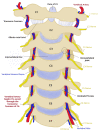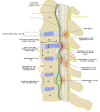Degenerative Cervical Myelopathy: An Overview
- PMID: 38213348
- PMCID: PMC10783125
- DOI: 10.7759/cureus.50387
Degenerative Cervical Myelopathy: An Overview
Abstract
Degenerative cervical myelopathy (DCM) is a spinal condition of growing importance due to its increasing prevalence within the ageing population. DCM involves the degeneration of the cervical spine due to various processes such as disc ageing, osteophyte formation, ligament hypertrophy or ossification, as well as coexisting congenital anomalies. This article provides an overview of the literature on DCM and considers areas of focus for future research. A patient with DCM can present with a variety of symptoms ranging from mild hand paraesthesia and loss of dexterity to a more severe presentation of gait disturbance and loss of bowel/bladder control. Hoffman's sign and the inverted brachioradialis reflex are also important signs of this disease. The gold standard imaging modality is MRI which can identify signs of degeneration of the cervical spine. Other modalities include dynamic MRI, myelography, and diffusion tensor imaging. One important scoring system to aid with the diagnosis and categorisation of the severity of DCM is the modified Japanese Orthopaedic Association score. This considers motor, sensory, and bowel/bladder dysfunction, and categorises patients into mild, moderate, or severe DCM. DCM is primarily treated with surgery as this can halt disease progression and may even allow for neurological recovery. The surgical approach will depend on the location of degeneration, the number of cervical levels involved and the pathophysiological process. Surgical approach options include anterior cervical discectomy and fusion, corpectomy, or posterior approach (laminectomy ± fusion). Conservative management is also considered for some patients with mild or non-progressive DCM or for patients where surgery is not an option. Conservative treatment may include physical therapy, traction, or neck immobilisation. Future recommendations include research into the prevalence rate of DCM and if there is a difference between populations. Further research on the benefit of conservative management for patients with mild or non-progressive DCM would be recommended.
Keywords: anatomy; anterior cervical discectomy fusion; degenerative cervical myelopathy; literature review; modified japanese orthopaedic association score; musculoskeletal imaging; posterior cervical decompression and fusion; spinal surgery complication; surgical management of spine.
Copyright © 2023, Saunders et al.
Conflict of interest statement
The authors have declared that no competing interests exist.
Figures



References
-
- Degenerative cervical myelopathy: recognition and management. Kane SF, Abadie KV, Willson A. https://www.aafp.org/pubs/afp/issues/2020/1215/p740.html. Am Fam Physician. 2020;102:740–750. - PubMed
-
- Moore KL, Dalley AF, Agur AMR. Philadelphia, PA: Lippincott Williams & Wilkins; 2018. Clinically Oriented Anatomy.
-
- Hegazy A. Saarbrücken, Germany: Lap Lambert Academic Publishing; 2014. Clinical Embryology for Medical Students and Postgraduate Doctors.
Publication types
LinkOut - more resources
Full Text Sources
